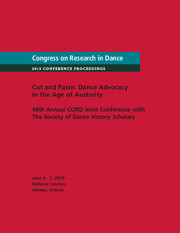No CrossRef data available.
Article contents
Virtual or Real: Symbols of Migration from the Fouta Djallon
Published online by Cambridge University Press: 04 January 2013
Abstract
The Baga of Guinea have developed masked performances that celebrate the movements of the ancestors from the highlands to the coast. The performance serves to legitimize the establishment of society in its current form and to reinforce the sense of place by reliving the process by which that place has become an identity. This paper is an attempt to analyze the complexity of the Baga choreographies of migration, concentrating on two costumed characters.
- Type
- Research Article
- Information
- Copyright
- Copyright © The Author(s) 2007
References
Works Cited
Alvares, Manuel, Teixeira a Mota, A., de Matos, Luis, and Hair, P. E. H.. 1990. Ethiopia Minor and a Geographical Account of the Province of Sierra Leone: (c. 1615). [Liverpool, England]: Dept. of History, University of Liverpool.Google Scholar
Coffinieres de Nordeck, André. 1886. “Voyage au pays des Baga et du Rio Nunez (1884–1885),” Le Tour du Monde. Nouveau journal des voyages. Paris: Hachette. 273–304.Google Scholar
La Voix de Notre Dame. (Les Pères de Saint Esprit, Conakry) I, no. I–XIV, no. 7 (November 1926–May 1939).Google Scholar
Lamp, Frederick J. 1996. Art of the Baga: A Drama of Cultural Reinvention. New York: Museum for African Art.Google Scholar
Niane, Djibril T. 1982. “Nimba, Goddess of Fertility in Baga Land.” Afrique Histoire 1.Google Scholar
Pacheco, Duarte Pereira. 1905. Esmeraldo de Situ Orbis (1506–1508). Lisbon: Typ Universal.Google Scholar
Paulme, Denise. 1957. “Structures sociales en pays baga,” Bulletin de l'IFAN 18, series B.Google Scholar
Arnoldi, Mary Jo. 1995. Playing with Time: Art and Performance in Central Mali. Bloomington: Indiana University Press.Google Scholar
Bangoura, Blez. 1974. L'Education Traditionnelle de la Jeunesse en Pays Baga: Baga Sitemu de Boké. Kankan, Guinea: Memoire, Institut Polytechnique Julius Nyerere.Google Scholar
Bangoura, Mohamed M. 1991. Patnè: Le Traditionalisme Baga. Conakry: La Commission Culturelle.Google Scholar
Bangura, Seku Beka. 1972. Croyances et Pratiques Religieuses des Baga Sitemu. Kankan, Guinea: Memoire, Institut Polytechnique Julius Nyere.Google Scholar
Blier, Suzanne P. 2004. “Ways of Experiencing African Art: The Role of Patina.” In Art of the Senses: African Masterpieces from the Teel Collection. Boston: Museum of Fine Arts.Google Scholar
Buckland, Theresa J., ed. 1999. Dance in the Field: Theory, Methods and Issues in Dance Ethnography. New York: St. Martin's.CrossRefGoogle Scholar
Camara, Abraham. 1975. L'Art Baga: Cadre de Reference Baga Sitemou de Boke. Conakry, Guinea: Memoire, Institut Polytechnique Gamal Abdel Nasser.Google Scholar
Conrad, David C. 1999. “Mooning Armies and Mothering Heroes: Female Power in Mande Epic Tradition.” In In Search of Sunjata: The Mande Epic as History, Literature and Performance, edited by Austen, R.. Bloomington: Indiana University Press.Google Scholar
Conrad, David C. 2004. Sunjata: A West African Epic of the Mande Peoples. Cambridge: Hackett.Google Scholar
Curtis, Marie Yvonne, and Sarro, Ramon. 1997. “The Nimba Headdress: Art, Ritual, and History of the Baga and Nalu Peoples” Museum Studies: African Art at the Art Institute of Chicago 22 (2).Google Scholar
Drewal, Henry John, and Drewal, Margaret Thompson. 1983. Gelede: Art and Female Power among the Yoruba. Bloomington: Indiana University Press.Google Scholar
Drewal, Margaret. 1992. Yoruba Ritual: Performance, Play, Agency. Bloomington: Indiana University Press.Google Scholar
Lamp, Frederick J. 2004. See the Music, Hear the Dance: Rethinking African Art at the Baltimore Museum of Art. Munich: Prestel Verlag.Google Scholar
Lawal, Babatunde. 1996. The Gelede Spectacle: Art, Gender, and Social Harmony in an African Culture. Seattle: University of Washington Press.Google Scholar
Paulme, Denise. 1956. “Des riziculteurs africains: les Baga,” Cahier d'Outre-Mer (10).Google Scholar
Phillips, Miriam S. 1987. “Where the Spirit Roams: Toward an Understanding of Duende.” UCLA Journal of Dance Ethnology 2.Google Scholar
Phillips, Miriam S. 1991. “A Shared Technique/Shared Roots? A Comparison of Kathak and Flamenco Dance History.” In Proceedings of the Society of Dance History Scholars. Riverside, CA: Society of Dance History Scholars.Google Scholar
Phillips, Ruth. 1995. Representing Woman: Sande Masquerades of the Mende of Sierra Leone. Los Angeles: Fowler Museum of Cultural History, UCLA.Google Scholar
Polak, Rainer. 1998. “Jenbe Music in Bamako: Microtiming as Formal Model and Performance Practice.” Iwalewa-Forum 2.Google Scholar
Polak, Rainer. 2004. Festmusik als Arbeit, Trommeln als Beruf: Jenbe-Spieler in einer westafrikanischen Grossstadt. Berlin: Dietrich Reimer.Google Scholar
Read, Daniel B. 2003. Dan Ge Performance: Masks and Music in Contemporary Côte d'Ivoire. Bloomington: Indiana University Press.CrossRefGoogle Scholar
Sarró, Ramon. 2005. “Elders Cathedrals and Children's Marbles: Dynamics of Religious Transmission among Baga of Guinea.” In On the Margins of Religions, edited by Pine, F. and Pina-Cabral, J.. Oxford: Begham.Google Scholar


